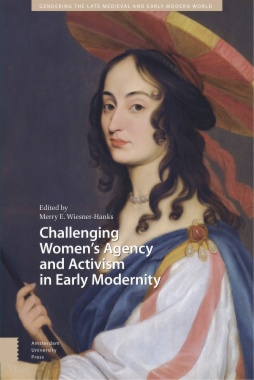Examining women’s agency in the past has taken on new urgency in the current moment of resurgent patriarchy, Women’s Marches, and the global #MeToo movement. The essays in this collection consider women’s agency in the Renaissance and early modern period, an era that also saw both increasing patriarchal constraints and new forms of women’s actions and activism. They address a capacious set of questions about how women, from their teenage years through older adulthood, asserted agency through social practices, speech acts, legal disputes, writing, viewing and exchanging images, travel, and community building. Despite family and social pressures, the actions of girls and women could shape their lives and challenge male-dominated institutions. This volume includes thirteen essays by scholars from various disciplines, which analyze people, texts, objects, and images from many different parts of Europe, as well as things and people that crossed the Atlantic and the Pacific.
- Cover
- Table of Contents
- Introduction
- Part I: Choosing and Creating
- 1. Bad Habits and Female Agency
- Attending to Early Modern Women in the Material History of Intoxication
- 2. Setting up House
- Artisan Women’s Trousseaux in Seventeenth-Century Bologna
- 3. Crafting Habits of Resistance
- Susan Dinan, Karen Nelson, and Michele Osherow
- Part II: Confronting Power
- 4. Confronting Women’s Actions in History
- Female Crown Fief Holders in Denmark
- 5. Divisive Speech in Divided Times?
- Women and the Politics of Slander, Sedition, and Informing during the English Revolution
- 6. Why Political Theory is Women’s Work
- How Moderata Fonte Reclaimed Liberty for Women inside and outside Marriage
- 7. ‘Wrestling the World from Fools’
- Teaching Historical Empathy and Critical Engagement in Traditional and Online Classrooms
- Part III: Challenging Representations
- 8. Thinking Beings and Animate Matter
- Margaret Cavendish’s Challenge to the Early Modern Order of Things
- 9. The Agency of Portrayal
- The Active Portrait in the Early Modern Period
- Saskia Beranek and Sheila ffolliott
- 10. Marking Female Ocular Agency in the ‘Medieval Housebook’
- Part IV: Forming Communities
- 11. Claude-Catherine de Clermont
- A Taste-Maker in the Continuum of Salon Society
- 12. Religious Spaces in the Far East
- Women’s Travel and Writing in Manila and Macao
- 13. Accounting for Early Modern Women in the Arts
- Reconsidering Women’s Agency, Networks, and Relationships
- Theresa Kemp, Catherine Powell, and Beth Link
- Index
- List of figures and tables
- Figure 1.1: Two eighteenth-century snuffboxes. Image Courtesy of John H Bryan II.
- Figure 1.2: Cowrie-shell snuffbox, dated 1748.
Image courtesy of Yale University Art Gallery.
- Figure 1.3: Silver snuffbox. Image Courtesy of Yale University Art Gallery.
- Figure 1.4: Snuffbox with a female textile worker. Image courtesy of John H Bryan II.
- Figure 1.5: Snuffbox with phallic image. Photo: author.
- Figure 1.6: Engraved snuff-gourd. Image courtesy of John H Bryan II.
- Figure 1.7: Knitting sheath front face. Image courtesy of John H Bryan II.
- Figure 1.8: Knitting sheath rear face. Image courtesy of John H Bryan II.
- Figure 3.1: Esther and Ahasuerus (1665) © Victoria and Albert Museum, London.
- Figure 3.2: ‘A Heroine Forcibly Enters a Jail to Liberate a Hero’, Freer Sackler accession S1986.399, Purchase—Smithsonian Unrestricted Trust Funds, Smithsonian Collections Acquisition Program, and Dr. Arthur M. Sackler, www.freersackler.si.edu/object/S19
- Figure 8.1: Margaret Cavendish, Poems, or several Fancies in Verse. With the Animal Parliament, in Prose (London: A. Maxwell, 1668), frontispiece. Engraving by Abraham von Diepenbeeck. 720.h.28. ©British Library Board.4
- Figure 9.1: Nicholas Hilliard (1547–1619), Elizabeth I (1533–1603) c.1580-1585. Watercolor on vellum laid on paper | 3.8 x 3.3 cm (support, canvas/panel/str external) | RCIN 422026.
- Figure 9.2: Sofonisba Anguissola, Isabel de Valois holding a Portrait of Philip II. Copyright ©Museo Nacional del Prado.
- Figure 9.3: Circle of François Clouet, Henri II (Paris: Louvre).
- Figure 10.1: Housebook Master, Military Encampment, drawing from the Medieval Housebook, begun c. 1475, fols. 53r–53r1. Private collection, public domain.
- Figure 10.2: Detail of Fig. 10.1.
- Figure 10.3: Master of the Getty Lalaing, ‘Jacques de Lalaing and Diego de Guzman Jousting before the King of Castile’, illumination from the Book of Deeds of Jacques de Lalaing, c. 1530. Los Angeles, The J. Paul Getty Museum, Acquired in honor of Thomas
- Figure 10.4: Housebook Master, Colonel Joust, drawing from the Medieval Housebook (see caption for Fig. 10.1), fols. 20v–21r.
- Figure 10.5: Housebook Master, A Woman in a Tower Scaled by Three Men, drawing from the Medieval Housebook (see caption for Fig. 10.1), fol. 53v1.
- Figure 10.6: Paris, Casket Lid with Scenes of Courtly Love and Jousting, 1310–30, elephant ivory, 5 7/8 x 9 7/8 x 5/16 in. (15 x 25.1 x 0.8 cm). New York, Metropolitan Museum of Art, Gift of J. Pierpont Morgan, 17.190.173a, b; The Cloisters Collection, 19
- Figure 10.7: Housebook Master, Seductions and Entrapments, from the Medieval Housebook (see caption for Figure 10.1), fols. 23v–24r.
- Figure 10.8: Housebook Master, Garden of Lust, from the Medieval Housebook (see caption for Fig. 1), fols. 24v–25r.

